EDEM Investigation and Experimental Evaluation of Abrasive Wear Resistance Performance of Bionic Micro-Thorn and Convex Hull Geometrically Coupled Structured Surface
Abstract
:Featured Application
Abstract
1. Introduction
2. Materials and Methods
2.1. Bionic Prototype and Geomerical Sturctured Suface Design
2.2. Abrasive Wear Testing System and Procedure
2.3. Settings Material Properties and Contact Parameters in EDEM
2.4. Settings of EDEM Contact Model and Theoretical Basis
3. Results and Discussion
3.1. Abrasion Loss and Worn Surface Micromorphology
3.2. Analysis of EDEM Simulation Results and Wear Mechanism Investigation
4. Conclusions
Author Contributions
Funding
Institutional Review Board Statement
Informed Consent Statement
Data Availability Statement
Acknowledgments
Conflicts of Interest
References
- Tong, J.; Mohammad, M.A.; Zhang, J.; Ma, Y.; Rong, B.; Chen, D.; Menon, C. DEM Numerical Simulation of Abrasive Wear Characteristics of a Bioinspired Ridged Surface. J. Bionic Eng. 2010, 7, 175–181. [Google Scholar] [CrossRef]
- Tong, J.; Zhang, Z.; Ma, Y.; Chen, D.; Jia, B.; Menon, C. Abrasive wear of embossed surfaces with convex domes. Wear 2012, 274, 196–202. [Google Scholar] [CrossRef]
- Khruschov, M.M. Principles of abrasive wear. Wear 1974, 28, 69–88. [Google Scholar] [CrossRef]
- Królicka, A.; Szczepański, Ł.; Konat, Ł.; Stawicki, T.; Kostencki, P. The influence of microstructure on abrasive wear micro-mechanisms of the claddings produced by welding used in agricultural soil. Materials 2020, 13, 1920. [Google Scholar] [CrossRef] [PubMed] [Green Version]
- Schramm, F.; Kalácska, Á.; Pfeiffer, V.; Sukumaran, J.; De Baets, P.; Frerichs, L. Modelling of abrasive material loss at soil tillage via scratch test with the discrete element method. J. Terramechan. 2020, 91, 275–283. [Google Scholar] [CrossRef]
- Horvat, Z.; Filipovic, D.; Kosutic, S.; Emert, R. Reduction of mouldboard plough share wear by a combination technique of hardfacing. Tribol. Int. 2008, 41, 778–782. [Google Scholar] [CrossRef]
- Kang, A.S.; Grewal, J.S.; Cheema, G.S. Effect of thermal spray coatings on wear behavior of high tensile steel applicable for tiller blades. Mater. Today Proc. 2017, 4, 95–103. [Google Scholar] [CrossRef]
- Frenzel, C.; Käsling, H.; Thuro, K. Factors influencing disc cutter wear. Geomech. Tunn. Geomech. Tunn. 2008, 1, 55–60. [Google Scholar] [CrossRef]
- Wang, S.; Li, S.; Zhang, Y.; Wan, Q.; Chen, H.; Meng, L. Mole toe bionics and surface heat treatment improving resistance reduction and abrasion resistance performance of toothed ditching blade. Trans. Chin. Soc. Agric. Eng. 2019, 35, 10–20. [Google Scholar]
- Liu, X.; Dong, L.; Yang, J.; Liu, Z.W.; Tao, J.; Wen, Q. Research on the Wear and Protection of Agricultural Implements. In Proceedings of the Computer Science and Engineering Technology (CSET2015) & Medical Science and Biological Engineering (MSBE2015), Hong Kong, China, 30–31 May 2015; pp. 61–66. [Google Scholar]
- Wang, J.; He, Q.Z.; Hu, Y.; Wang, M.C. Study on the Microstructure and Performance of New Type Martensite Wear Resistant Steel. Adv. Mater. Res. 2011, 199, 167–172. [Google Scholar] [CrossRef]
- Liu, H.; Wang, J.; Shen, B.; Yang, H.; Gao, S.; Huang, S. Influence of secondary carbide precipitation and transformation on abrasion resistance of a 3Cr15Mo1V1. 5 white iron. J. Univ. Sci. Technol. Beijing Miner. Metall. Mater. 2007, 14, 231–235. [Google Scholar]
- Wu, Z.; Liu, X. A new heat treatment process for blades of 65Mn steel stubble machine. Trans. Chin. Soc. Agric. Mach. 1994, 1994, 117–119. [Google Scholar]
- Li, Q.; Guo, J.; Hu, J. Research status of wear resistance and drag reduction treatment of soil cultivation components. Surf. Technol. 2017, 2017, 126–133. [Google Scholar]
- Ren, J.; Jin, S. Friction and wear characteristics of plasma-sprayed Al2O3-40% TiO2 and Cr2O3 coatings on aluminum alloy. Tribol. Int. 2000, 20, 18–21. [Google Scholar]
- Foley, A.; Lawton, P.; Barker, A.; McLees, V. The use of alumina ceramic to reduce wear of soil-engaging components. J. Agric. Eng. Res. 1984, 30, 37–46. [Google Scholar] [CrossRef]
- Foley, A.; Chisholm, C.; McLees, V. Wear of ceramic-protected agricultural subsoilers. Tribol. Int. 1988, 21, 97–103. [Google Scholar] [CrossRef]
- Yang, F.; Chen, X. Application of wear resistant materials in soil tillage components. J. Agric. Mech. Res. 2000, 2000, 111–112. [Google Scholar]
- Ren, L.; Liang, Y. Biological couplings: Classification and characteristic rules. Sci. China Ser. E Technol. Sci. 2009, 52, 2791–2800. [Google Scholar] [CrossRef]
- Ren, L.; Liang, Y. Biological couplings: Function, characteristics and implementation mode. Sci. China Technol. Sci. 2010, 53, 379–387. [Google Scholar] [CrossRef]
- Ren, L.; Liang, Y. Preliminary studies on the basic factors of bionics. Sci. China Technol. Sci. 2014, 57, 520–530. [Google Scholar] [CrossRef]
- Tan, L.; Zong, X.; Chang, Z. Design and test of biomimetic wear resistant for et clutch friction plate for heavy tractor. Trans. Chin. Soc. Agric. Eng. 2018, 34, 54–59. [Google Scholar]
- Ma, Y.; Lin, F.; Yan, Z. Micro morphology and properties of tribological action for shell in Cyclina sinensis. Trans. Chin. Soc. Agric. Eng. 2013, 29, 298–304. [Google Scholar]
- Zhang, R.; Yu, H.; Pang, H.; Chen, G.; Tai, W. Analysis of Wear-Resistant Surface with Pangolin Scale Morphology by DEM Simulation. Appl. Sci. 2020, 10, 2896. [Google Scholar] [CrossRef]
- Chen, L.; Zhou, H.; Zhao, Y.; Ren, L.; Li, X. Abrasive particle wear behaviors of several die steels with non-smooth surfaces. J. Mater. Process. Technol. 2007, 190, 211–216. [Google Scholar] [CrossRef]
- Zhang, J.; Tong, J.; Ma, Y. Abrasive wear characteristics of subsoiler tines with bionic rib structure surface. J. Jilin Univ. Eng. Technol. Ed. 2015, 45, 174–180. [Google Scholar]
- Hu, L.; Hu, G. Techniques and implementation of granular DEM simulation for mechanical product design. J. Mech. Eng. 2015, 51, 59–69. [Google Scholar]
- Rong, B. Biomimetic Geometrical Structure Surfaces with Anti-Abrasion Function and Their Abrasive Wear Against Soil; Jilin University: Changchun, China, 2008. [Google Scholar]
- Li, F.; Fu, K.; Yu, X. Optimization of grinding performance for large-type semi-autogenous mill based on analytic hierarchy process. Trans. Chin. Soc. Agric. Mach. 2017, 48, 392–398. [Google Scholar]
- Kalala, J.; Bwalya, M.; Moys, M. Discrete element method (DEM) modelling of evolving mill liner profiles due to wear. Part II. Industrial case study. Miner. Eng. 2005, 18, 1392–1397. [Google Scholar] [CrossRef]
- Franke, J.; Cleary, P.W.; Sinnott, M.D. How to account for operating condition variability when predicting liner operating life with DEM–A case study. Miner. Eng. 2015, 73, 53–68. [Google Scholar] [CrossRef]
- Chen, G.; Lodewijks, G.; Schott, D.L. Numerical prediction on abrasive wear reduction of bulk solids handling equipment using bionic design. Part. Sci. Technol. 2019, 37. [Google Scholar] [CrossRef]
- Chen, G.; Schott, D.L.; Lodewijks, G. Bionic design methodology for wear reduction of bulk solids handling equipment. Part. Sci. Technol. 2017, 35, 525–532. [Google Scholar] [CrossRef]
- Chen, G. DEM Simulation in Wear Behaviors of Bionic Structures Based on Four Wear-Resistant Biological Surface Morphologies; Jilin University: Changchun, China, 2012. [Google Scholar]
- Zhang, Z.; Zhang, G.; Tong, J.; Lai, Q.; Gao, X.; Tang, Y.; Carr, S. Microstructure and tribology characteristics of head and chest exoskeleton of Procambarusclarkii. Trans. Chin. Soc. Agric. Eng. 2018, 34, 52–58. [Google Scholar]
- Zhang, S.; Zhang, J.; Zhu, B.; Niu, S.; Han, Z.; Ren, L. Progress in bio-inspired anti-solid particle erosion materials: Learning from nature but going beyond nature. Chin. J. Mech. Eng. 2020, 33, 1–27. [Google Scholar] [CrossRef]
- Gong, S.; Li, L.; Lu, J. A study on burrowing behavior of Procambarus clarkii. Freshw. Fish. 2007, 37, 3–7. [Google Scholar]
- Chirende, B.; Li, J.; Wen, L.; Simalenga, T.E. Effects of bionic non-smooth surface on reducing soil resistance to disc ploughing. Sci. China Technol. Sci. 2010, 53, 2960–2965. [Google Scholar] [CrossRef]
- Wang, Z.; Wang, Z.; Chunxiang, Z. Experiment research on wear mechanism with bionic non-smoothed surface. Mater. Sci. Technol. 2006, 14, 275–278. [Google Scholar]
- Thakare, M.; Wharton, J.; Wood, R.; Menger, C. Effect of abrasive particle size and the influence of microstructure on the wear mechanisms in wear-resistant materials. Wear 2012, 276, 16–28. [Google Scholar] [CrossRef]
- Zhou, P. Effect of soil abrasive properties on wear performance of agricultural machinery materials. Trans. Chin. Soc. Agric. Mach. 1986, 1986, 55–64. [Google Scholar]
- Tong, J.; Ren, L.; Chen, B. Fractal dimension of soil particle-size distribution and their effects on soil adhesion behaviour. Trans. Chin. Soc. Agric. Eng. 1994, 1994, 27–33. [Google Scholar]
- Zhang, L.; Zhang, W.; Cai, G. Study on the thermal property parameters of PLA. China Plast. Ind. 2012, 40, 68–71. [Google Scholar]
- Van Name, F., Jr. Experiment for Measuring the Coefficient of Restitution. Am. J. Phys. 1958, 26, 386–388. [Google Scholar] [CrossRef]
- Zhang, G.; Xiang, X.; Tang, H. FieldI test and numerical calculation of restitution coefficient of rockfall collision. Chin. J. Rock Mech. Eng. 2011, 30, 1266–1273. [Google Scholar]
- Archard, J. Contact and rubbing of flat surfaces. J. Appl. Phys. 1953, 24, 981–988. [Google Scholar] [CrossRef]
- Van Liedekerke, P.; Tijskens, E.; Dintwa, E.; Rioual, F.; Vangeyte, J.; Ramon, H. DEM simulations of the particle flow on a centrifugal fertilizer spreader. Powder Technol. 2009, 190, 348–360. [Google Scholar] [CrossRef]
- Kim, J.-W.; Jung, S.; Kim, J.; Kim, J.; Seo, T. Optimal design of the front linkage of a hydraulic excavator for multi-objective function. J. Mech. Sci. Technol. 2014, 28, 3103–3111. [Google Scholar] [CrossRef]
- Yuan, C. Study of Surface Characteristics Both of Wear Particles & Wear Components and Their Relationship in Wear Process; Wuhan University of Technology: Wuhan, China, 2005. [Google Scholar]
- Zhang, J.; Zhang, Q.; Ge, Y.; Jiang, Y. Analysis of the Wear-Resistance Characteristics of Bionic Ridge Structures. Appl. Eng. Agric. 2020, 36, 697–702. [Google Scholar] [CrossRef]
- Bhushan, B. Introduction to Tribology; John Wiley & Sons: Hoboken, NJ, USA, 2013. [Google Scholar]
- Tong, J.; Lü, T.-B.; Ma, Y.-H.; Wang, H.-K.; Ren, L.-Q.; Arnell, R. Two-body abrasive wear of the surfaces of pangolin scales. J. Bionic Eng. 2007, 4, 77–84. [Google Scholar] [CrossRef]
- Tong, J.; Wang, H.; Ma, Y.; Ren, L. Two-body abrasive wear of the outside shell surfaces of mollusc Lamprotula fibrosa Heude, Rapana venosa Valenciennes and Dosinia anus Philippi. Tribol. Lett. 2005, 19, 331–338. [Google Scholar] [CrossRef]
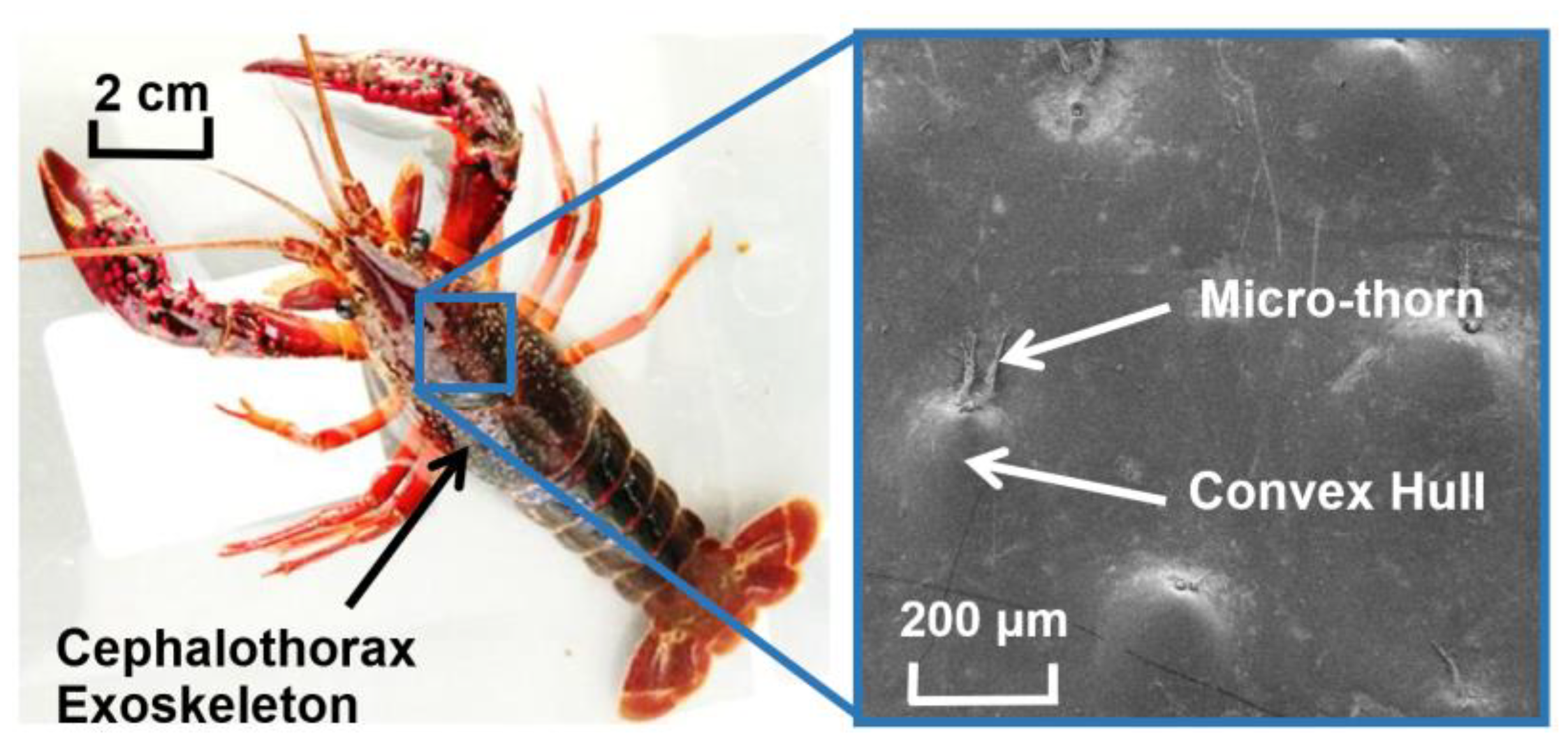
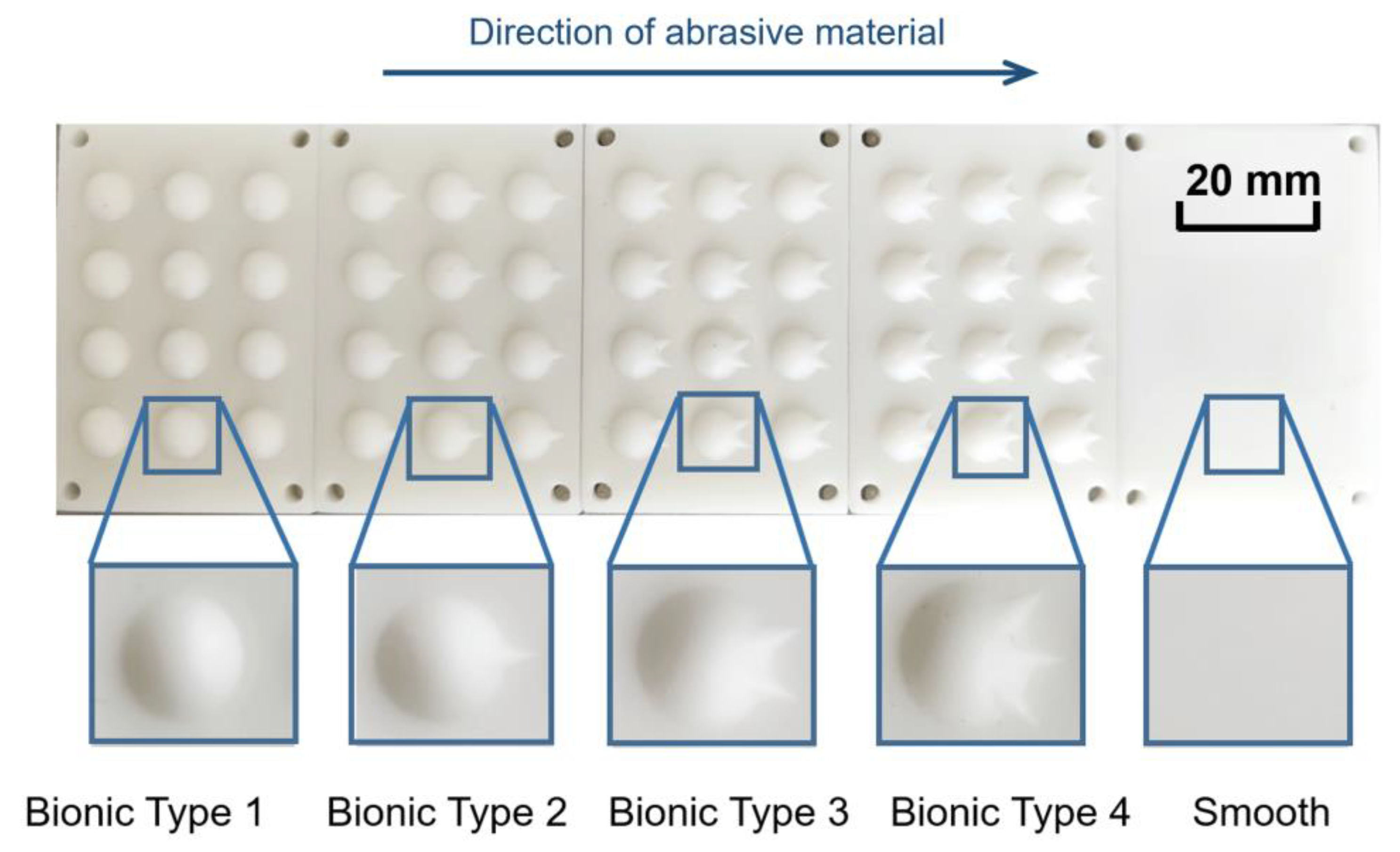
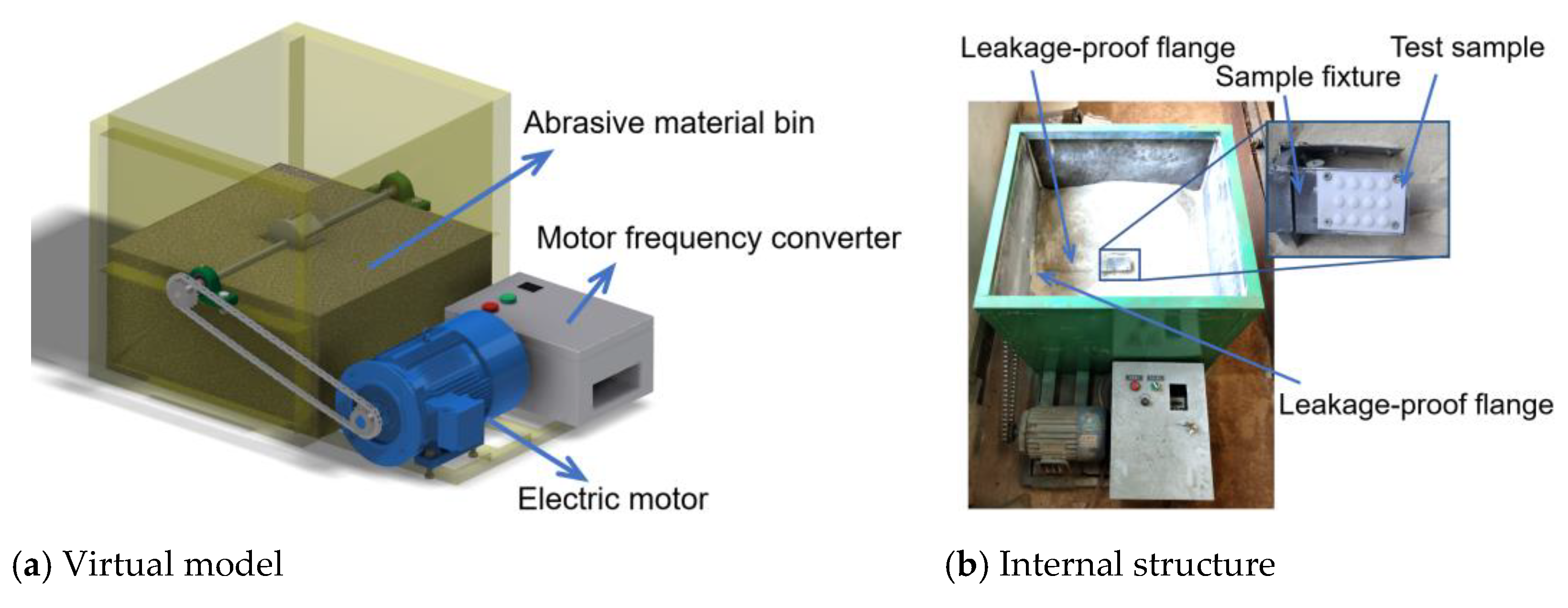
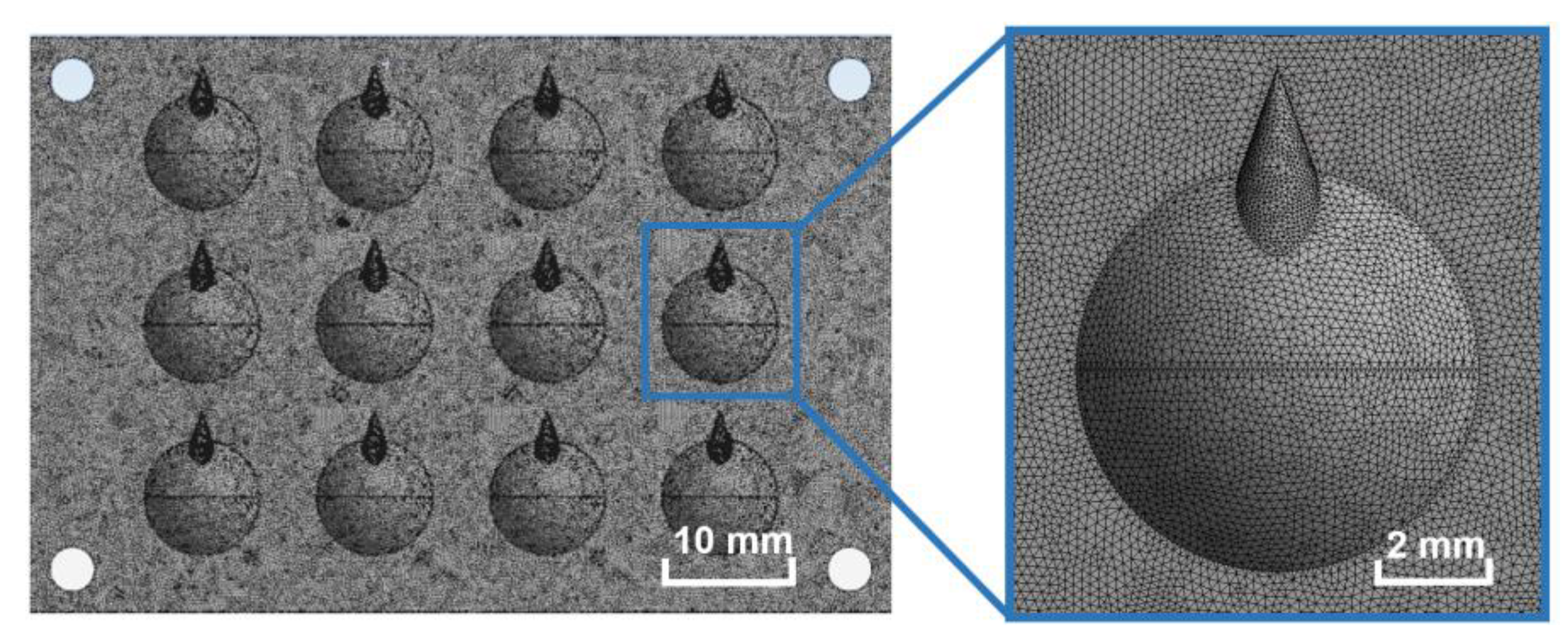
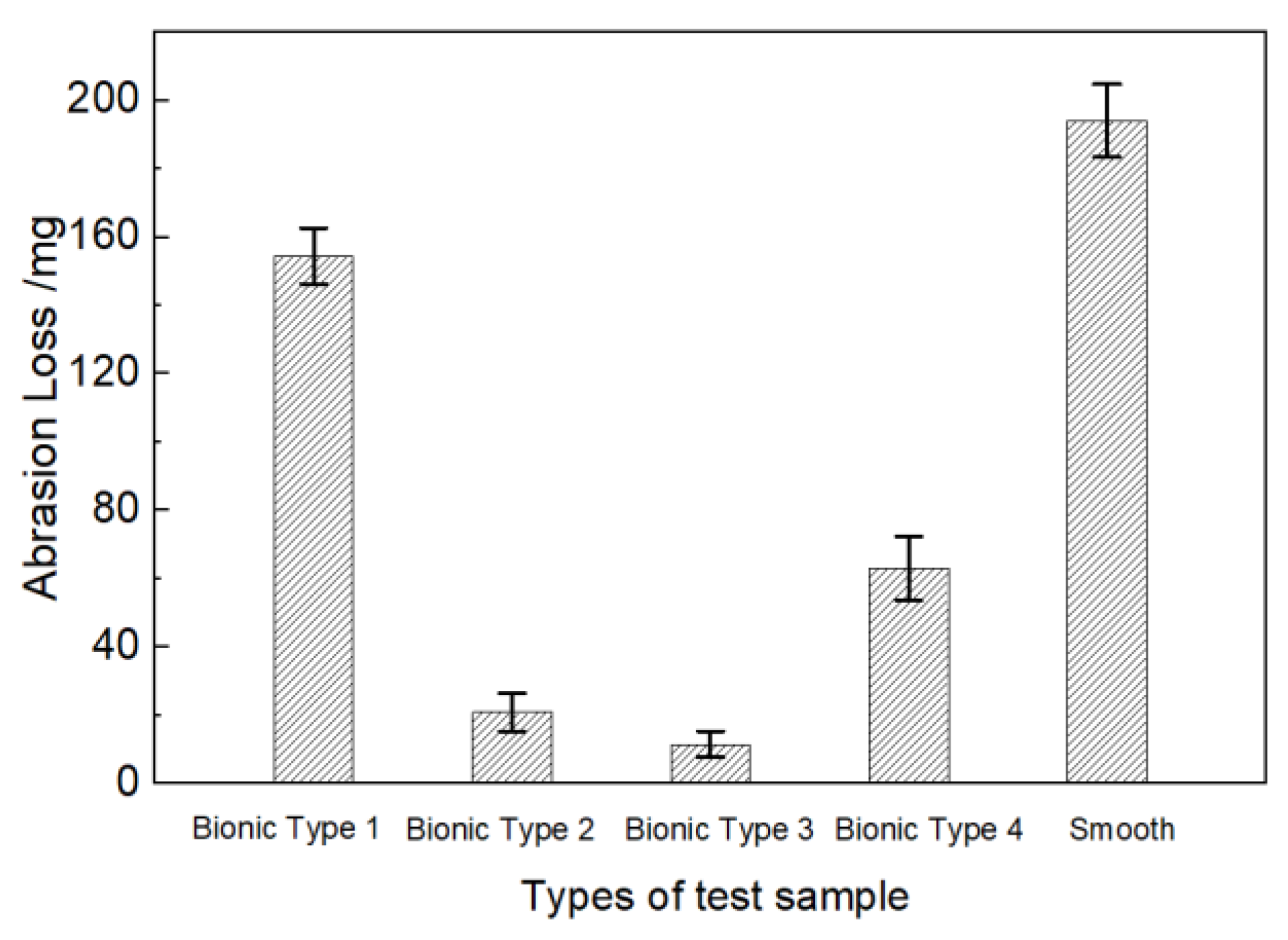
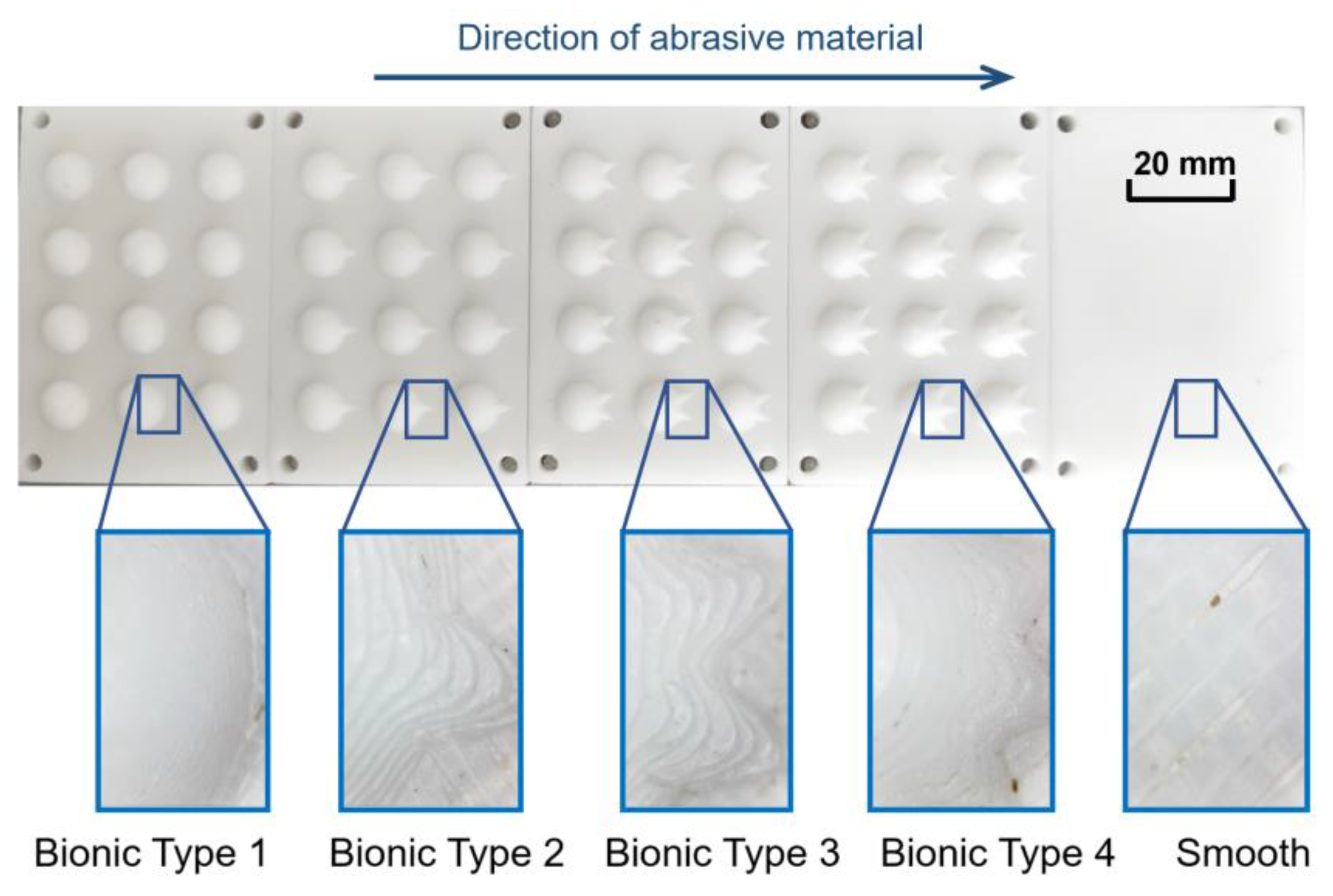
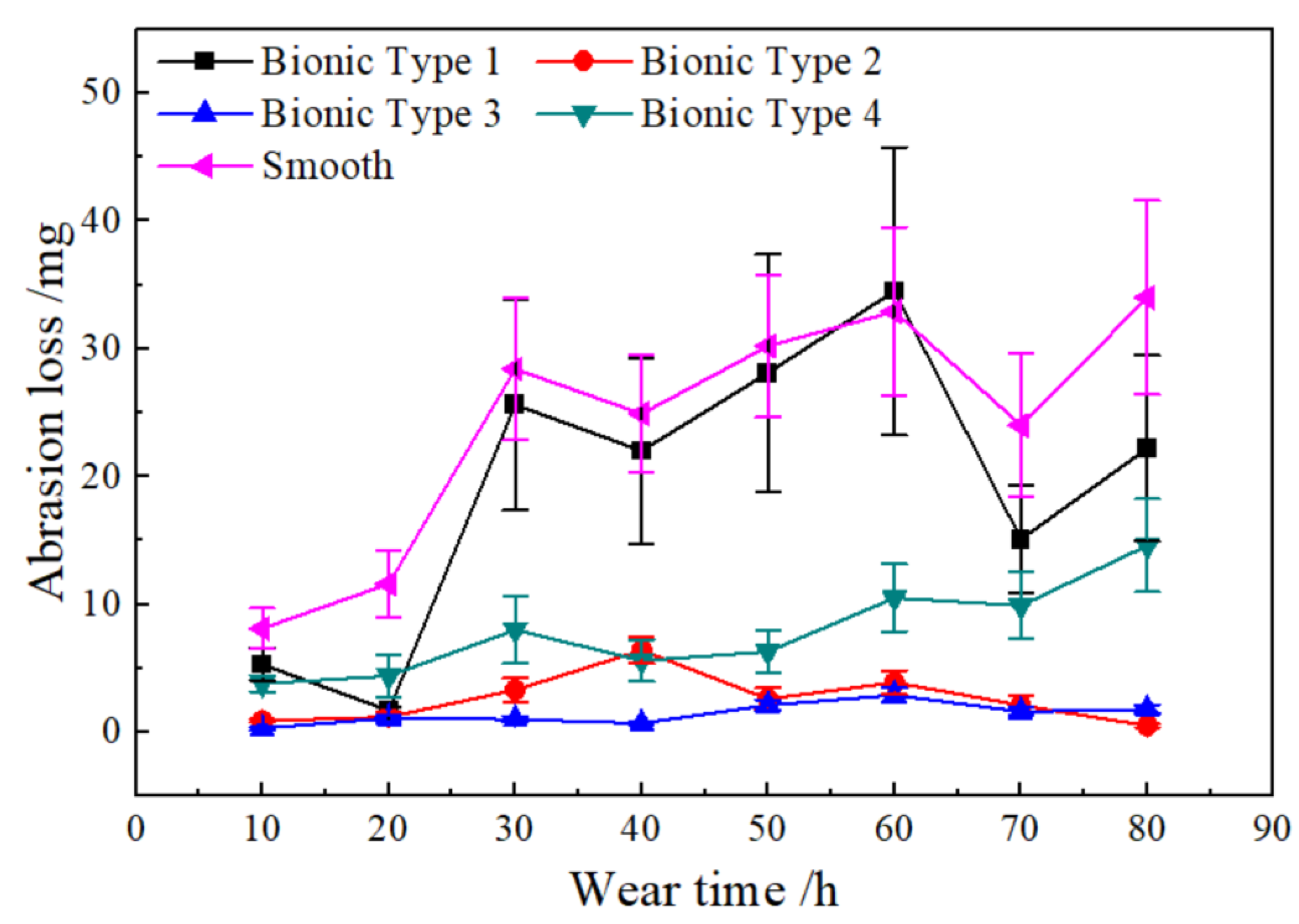
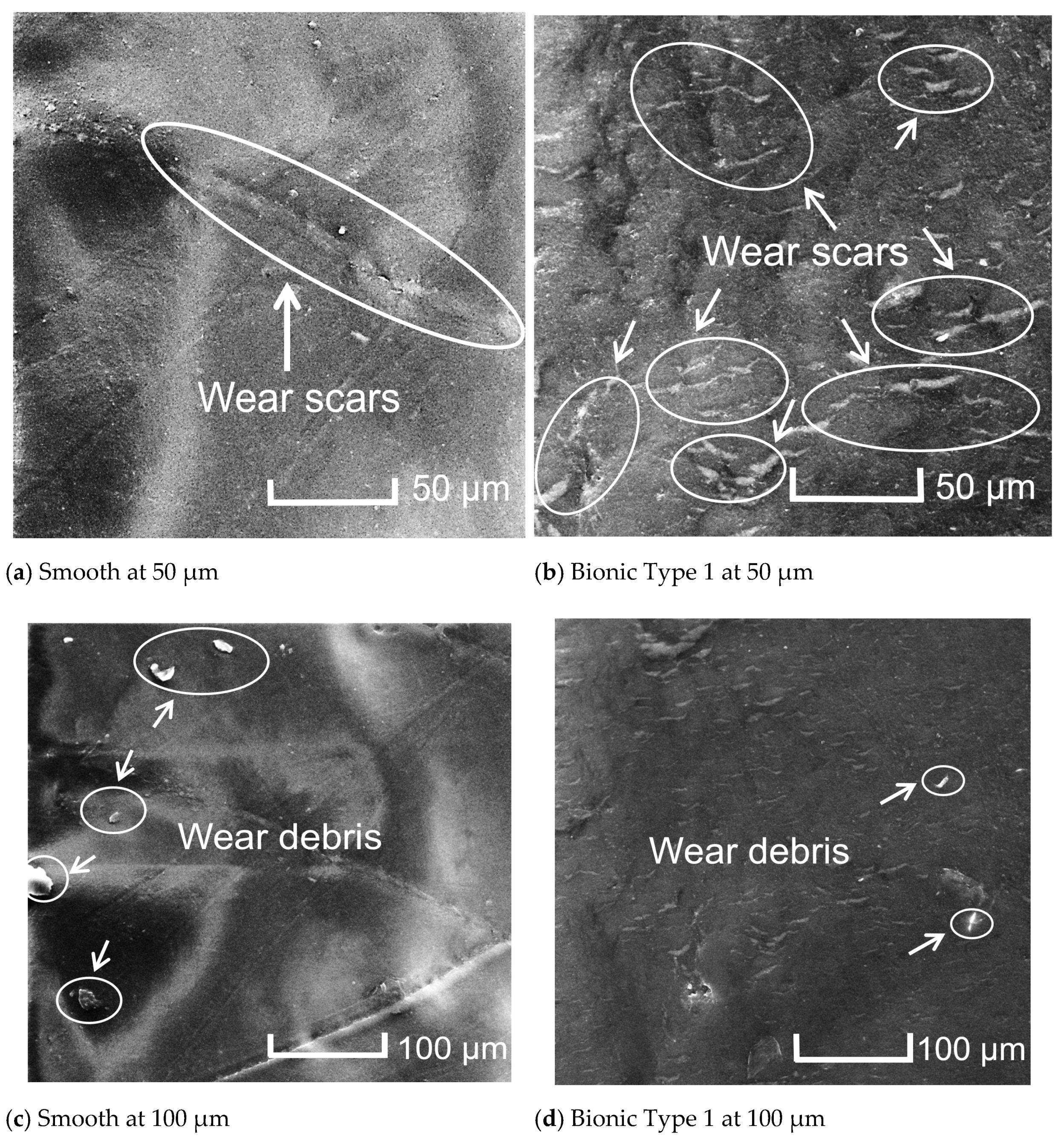
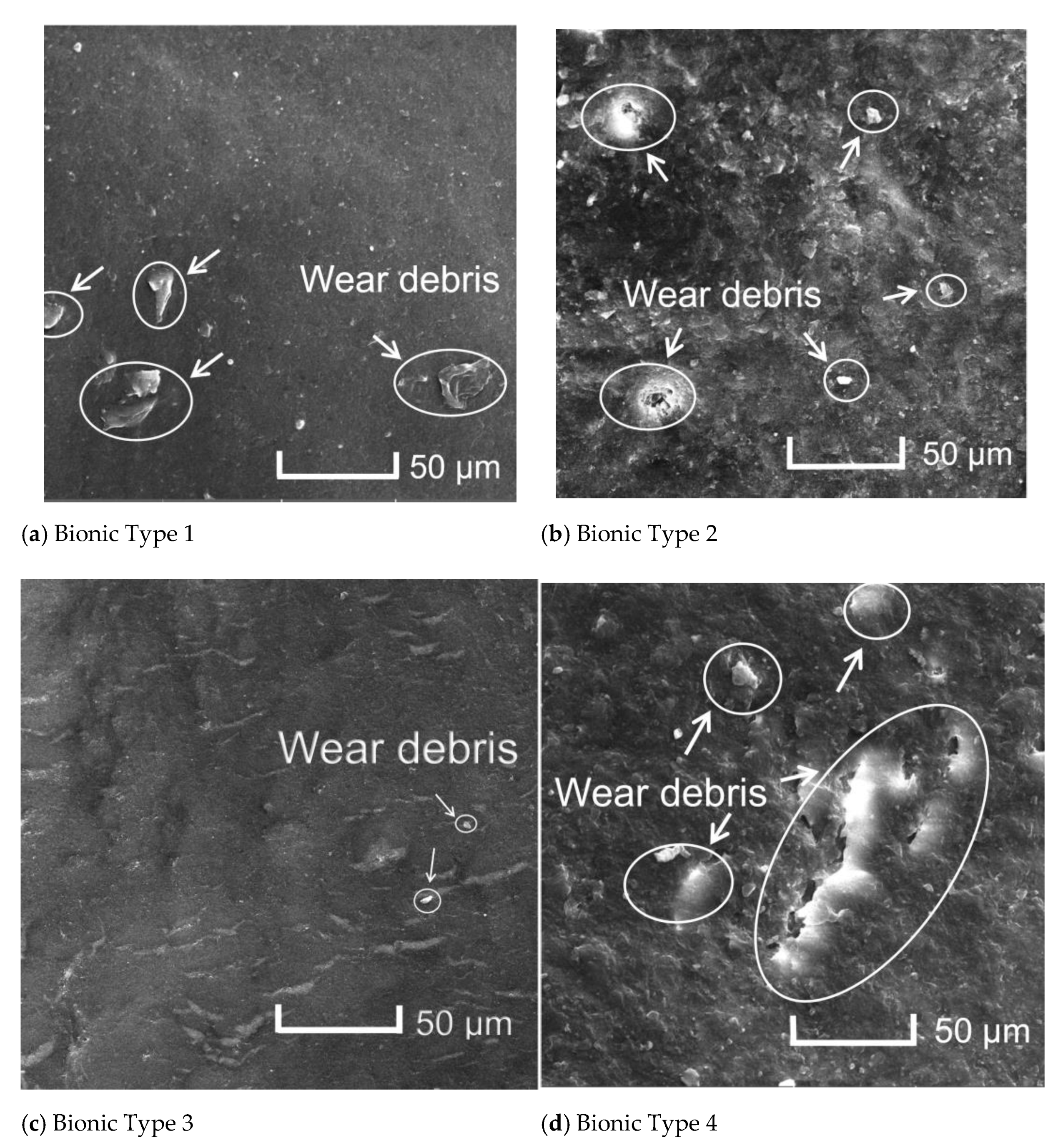

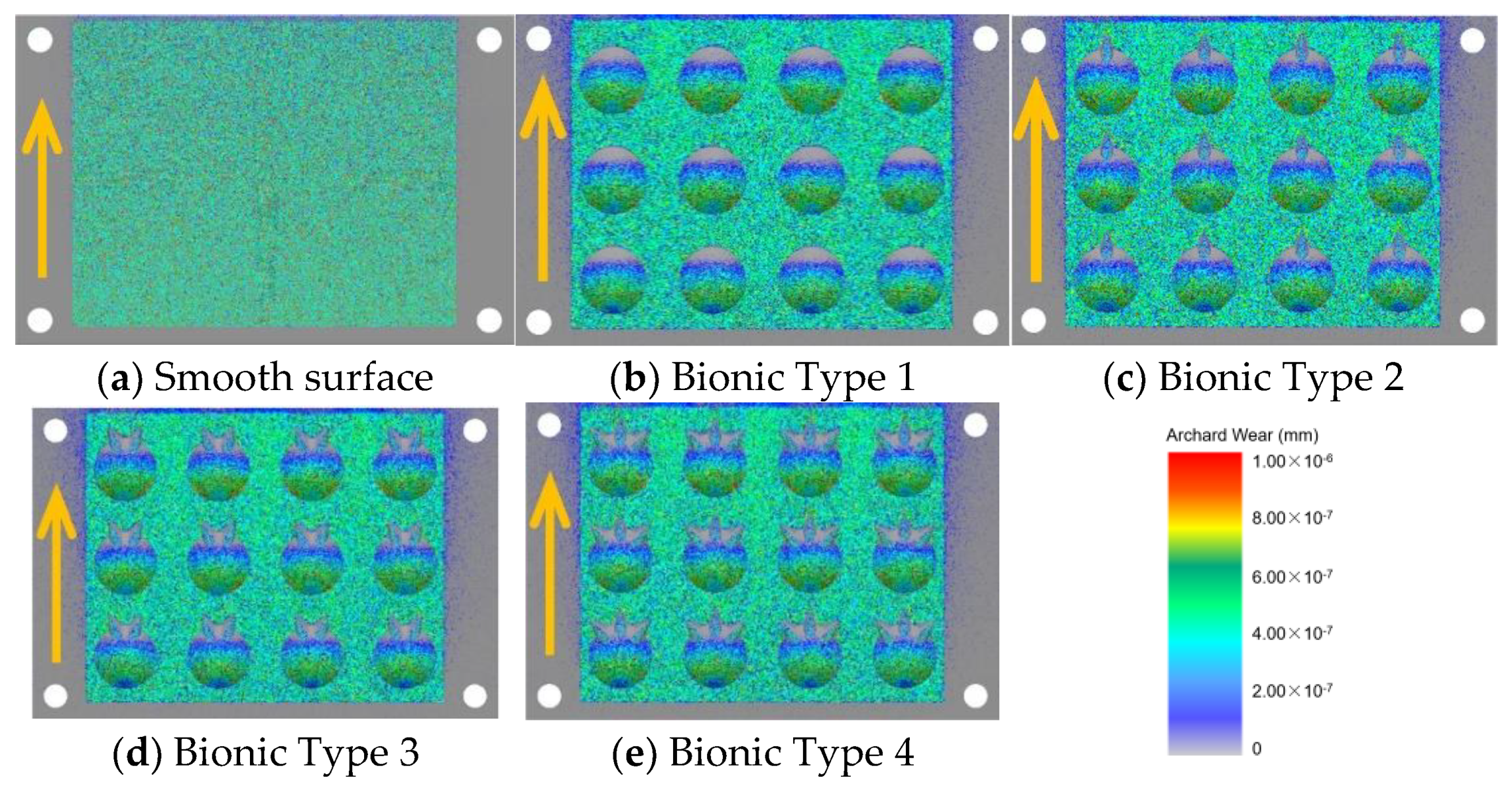

| Type | Parameter | Value |
|---|---|---|
| Quartz sand | Shear modulus/GPa | 0.2 |
| Poisson’s ratio | 0.25 | |
| Density/kg·m−3 | 2350 | |
| PLA | Shear modulus/GPa | 1.4 |
| Poisson’s ratio | 0.35 | |
| Density/kg·m−3 | 1248 | |
| Contact between quartz sand particles | Coefficient of restitution | 0.3 |
| Static friction factor | 0.5 | |
| Rolling friction factor | 0.01 | |
| Contacts between quartz sand and PLA | Coefficient of restitution | 0.2 |
| Static friction factor | 0.5 | |
| Rolling friction factor | 0.01 |
| Type of Samples | Bionic Type 1 | Bionic Type 2 | Bionic Type 3 | Bionic Type 4 | Smooth |
|---|---|---|---|---|---|
| Averaged wear depth/10−7 mm | 1.7221 | 1.5741 | 1.5656 | 1.6293 | 1.9766 |
Publisher’s Note: MDPI stays neutral with regard to jurisdictional claims in published maps and institutional affiliations. |
© 2021 by the authors. Licensee MDPI, Basel, Switzerland. This article is an open access article distributed under the terms and conditions of the Creative Commons Attribution (CC BY) license (https://creativecommons.org/licenses/by/4.0/).
Share and Cite
Zhang, Q.; Zuo, G.; Lai, Q.; Tong, J.; Zhang, Z. EDEM Investigation and Experimental Evaluation of Abrasive Wear Resistance Performance of Bionic Micro-Thorn and Convex Hull Geometrically Coupled Structured Surface. Appl. Sci. 2021, 11, 6655. https://doi.org/10.3390/app11146655
Zhang Q, Zuo G, Lai Q, Tong J, Zhang Z. EDEM Investigation and Experimental Evaluation of Abrasive Wear Resistance Performance of Bionic Micro-Thorn and Convex Hull Geometrically Coupled Structured Surface. Applied Sciences. 2021; 11(14):6655. https://doi.org/10.3390/app11146655
Chicago/Turabian StyleZhang, Qingzhu, Guobiao Zuo, Qinghui Lai, Jin Tong, and Zhihong Zhang. 2021. "EDEM Investigation and Experimental Evaluation of Abrasive Wear Resistance Performance of Bionic Micro-Thorn and Convex Hull Geometrically Coupled Structured Surface" Applied Sciences 11, no. 14: 6655. https://doi.org/10.3390/app11146655
APA StyleZhang, Q., Zuo, G., Lai, Q., Tong, J., & Zhang, Z. (2021). EDEM Investigation and Experimental Evaluation of Abrasive Wear Resistance Performance of Bionic Micro-Thorn and Convex Hull Geometrically Coupled Structured Surface. Applied Sciences, 11(14), 6655. https://doi.org/10.3390/app11146655





